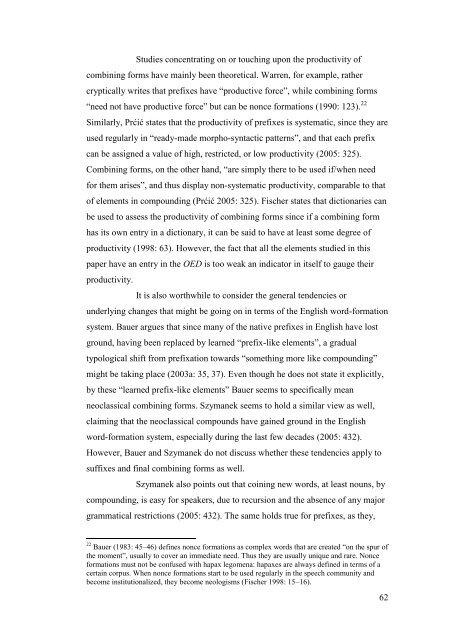The morphological productivity of selected ... - Helda - Helsinki.fi
The morphological productivity of selected ... - Helda - Helsinki.fi
The morphological productivity of selected ... - Helda - Helsinki.fi
You also want an ePaper? Increase the reach of your titles
YUMPU automatically turns print PDFs into web optimized ePapers that Google loves.
Studies concentrating on or touching upon the <strong>productivity</strong> <strong>of</strong><br />
combining forms have mainly been theoretical. Warren, for example, rather<br />
cryptically writes that pre<strong>fi</strong>xes have “productive force”, while combining forms<br />
“need not have productive force” but can be nonce formations (1990: 123). 22<br />
Similarly, Prćić states that the <strong>productivity</strong> <strong>of</strong> pre<strong>fi</strong>xes is systematic, since they are<br />
used regularly in “ready-made morpho-syntactic patterns”, and that each pre<strong>fi</strong>x<br />
can be assigned a value <strong>of</strong> high, restricted, or low <strong>productivity</strong> (2005: 325).<br />
Combining forms, on the other hand, “are simply there to be used if/when need<br />
for them arises”, and thus display non-systematic <strong>productivity</strong>, comparable to that<br />
<strong>of</strong> elements in compounding (Prćić 2005: 325). Fischer states that dictionaries can<br />
be used to assess the <strong>productivity</strong> <strong>of</strong> combining forms since if a combining form<br />
has its own entry in a dictionary, it can be said to have at least some degree <strong>of</strong><br />
<strong>productivity</strong> (1998: 63). However, the fact that all the elements studied in this<br />
paper have an entry in the OED is too weak an indicator in itself to gauge their<br />
<strong>productivity</strong>.<br />
It is also worthwhile to consider the general tendencies or<br />
underlying changes that might be going on in terms <strong>of</strong> the English word-formation<br />
system. Bauer argues that since many <strong>of</strong> the native pre<strong>fi</strong>xes in English have lost<br />
ground, having been replaced by learned “pre<strong>fi</strong>x-like elements”, a gradual<br />
typological shift from pre<strong>fi</strong>xation towards “something more like compounding”<br />
might be taking place (2003a: 35, 37). Even though he does not state it explicitly,<br />
by these “learned pre<strong>fi</strong>x-like elements” Bauer seems to speci<strong>fi</strong>cally mean<br />
neoclassical combining forms. Szymanek seems to hold a similar view as well,<br />
claiming that the neoclassical compounds have gained ground in the English<br />
word-formation system, especially during the last few decades (2005: 432).<br />
However, Bauer and Szymanek do not discuss whether these tendencies apply to<br />
suf<strong>fi</strong>xes and <strong>fi</strong>nal combining forms as well.<br />
Szymanek also points out that coining new words, at least nouns, by<br />
compounding, is easy for speakers, due to recursion and the absence <strong>of</strong> any major<br />
grammatical restrictions (2005: 432). <strong>The</strong> same holds true for pre<strong>fi</strong>xes, as they,<br />
22 Bauer (1983: 45–46) de<strong>fi</strong>nes nonce formations as complex words that are created “on the spur <strong>of</strong><br />
the moment”, usually to cover an immediate need. Thus they are usually unique and rare. Nonce<br />
formations must not be confused with hapax legomena: hapaxes are always de<strong>fi</strong>ned in terms <strong>of</strong> a<br />
certain corpus. When nonce formations start to be used regularly in the speech community and<br />
become institutionalized, they become neologisms (Fischer 1998: 15–16).<br />
62
















